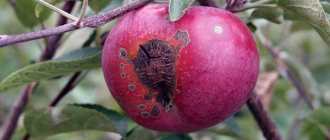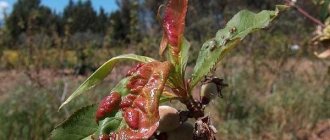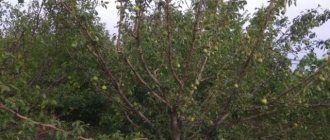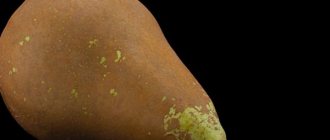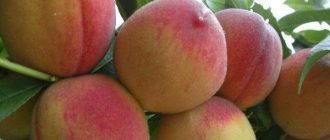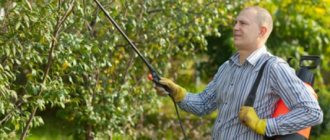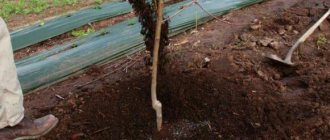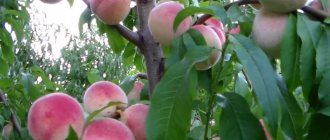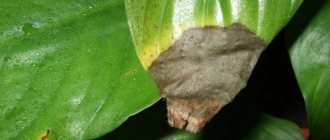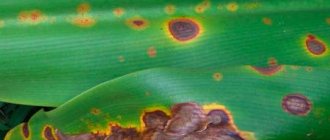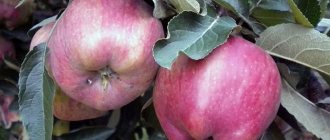Immune varieties
It is impossible to guarantee one hundred percent that one or another type of peach will not be infected with the described fungus.
However, it’s still worth a try and choose a variety with better resistance to this most dangerous disease. Moreover, there are varieties of peach in the form of varieties Early Kuban, Sochnogo, Favorita Morettini, Pamyati Rodionov, Redhaven, Kievsky Early, Saturn, September Yellow, which are not susceptible to infection by the fungus.
Varieties of peaches resistant to disease
According to gardeners, peach tree species that have fruits with yellow, fleshy pulp are less likely to develop leaf curl. The greatest disease resistance to fungal diseases was recorded in the following varieties:
- Golden Moscow;
- Kyiv early;
- Golden Jubilee;
- Early Simferopol;
- Kuban is early.
Regardless of what type of peach was chosen, prevention is the best way to protect the plant from curling. Peach plantations are pampered, heat-loving areas. The tree will quickly die if you do not follow agricultural practices and preventive options for protection against damage by fungi and pests.
0
0
Copy link
Causes and factors of disease manifestation
At the initial stage of the disease, the lower surface of young leaves is covered with a whitish coating formed by marsupial sporulation of this fungus.
The causative agent of the described disease spends its wintering in the form of budding ascospores between the scales of the buds or in cracks in the bark of trees. And weather favorable for the fungus with rain, dampness and coolness provokes its development and further infection of the tree. That is why the arrival of spring can contribute to a new outbreak of the disease.
Causes of infection
The main reasons for the activation of the fungus are:
- cool spring;
- high humidity;
- thickened crown with poor ventilation (incorrect, insufficient pruning or lack thereof);
- tight fits;
- invasions of insects that are carriers of fungal spores;
- microcracks on the branches and trunk, which are the gateway for fungal infection.
Humans cannot influence the climatic conditions that are favorable for the development of curly hair. But it is within his power to regularly carry out preventive agrotechnical measures.
Signs of tree infection
Curliness in the described culture initially manifests itself in the form of greenish swellings on the leaf blade, which subsequently turn red and darken. The tissues of the leaves thicken, and due to underdevelopment and uneven growth, they curl. Infected leaves, covered with a so-called waxy coating, turn black over time, dry out and die.
Tree branches are also subject to infection, which manifests itself in the form of:
- gum formation;
- shoot deformations;
- visible yellowness;
- drying.
See also
Description and characteristics of varieties and types of peaches, selection rules for regionsRead
After the foliage dies, the ovaries also die.
Prevention
It is worth thinking about prevention even at the stage of purchasing seedlings.
Step 1. Selecting a seedling
You need to choose peach varieties that are resistant to curl. Such as:
- Big Honey;
- Volcano;
- Erlired;
- Yellow Donetsk;
- Kyiv 12, Kyiv early, Kuban;
- Nectared 4;
- In memory of Rodionov;
- Early Kuban, Redhaven;
- Sunhaven, Saturn, September Yellow, Simferopol Early, Juicy, Springtime, Stark Red Gold;
- Morettini's favorite;
- Harou Diamond.
However, there are some nuances here too. As practice shows, even the above varieties, declared as resistant to curl, can become infected with fungus. This happens rarely, and yet there is no 100% guarantee of safety. Even after acquiring such seedlings, one must not forget about the appropriate preventive measures and carry them out regularly.
Step 2. Landing
Whatever variety of peach you buy, you need to be wise when choosing a place to plant it. Remember what conditions are favorable for the activation and spread of fungus (humidity and dampness). Therefore, locate the seedling where it is dry, warm and has plenty of sunlight most of the time.
For the same purpose, arrange good drainage in the planting hole so that water does not stagnate in it.
When planting, do not place seedlings close to each other. The contact of branches in the future will contribute to increased humidity and the formation of diaper rash inside the crown. These are excellent conditions for the activation of fungal diseases (including leaf curl).
Do not choose areas for planting where strawberries, melons or nightshade plants previously grew.
Step 3: Trimming
From the very beginning, shape the peach crown correctly so that it is not too thick. Poor ventilation is a factor that provokes the formation of wet areas inside it. Fungi love them.
Step 4. Fungicide treatment
The main preventative measure against curl is regular seasonal spraying with fungicides. The approximate timing of preventive treatments is indicated in the table:
The table lists only chemical and biological drugs. If someone prefers to use exclusively folk remedies, they can use them. Cooking recipes are given above. When performing preventive spraying, it is recommended to mix fungicides with pesticides in order to at the same time prevent the invasion of insects (which are often carriers of fungal spores).
Step 5. Agricultural technology
As preventive agrotechnical measures, you should:
- in the fall, collect biomaterial that has fallen from trees (leaves, branches, fruits) and burn it or send it to humus in a compost pit (this applies not only to peaches, but to all trees in the garden);
- clear tree trunk circles from weeds and carry out deep loosening;
- choose an irrigation scheme that prevents waterlogging of the soil;
- throughout the growing season, feed with organic and mineral fertilizers;
- Be sure to cover it thoroughly for the winter.
All preventive measures must be regular.
How dangerous is the disease?
In advanced cases, when affected by the described fungus, against the background of loss of ovaries and shoots, the tree slows down its growth. Peach fruits lose their taste and become unfit for consumption.
The winter hardiness of the crop decreases. In winter, the affected shoots die, the tree becomes susceptible to frost, and then, during the fruiting period, ceases to produce crops.
Without treatment, literally after a few years, the infected peach crop dies.
Symptoms
Gardeners can recognize the disease by the following signs:
- The surface of young, just blossoming leaves becomes curved and wavy.
- The leaves lose their elasticity and become brittle.
- Certain areas on mature leaves become swollen and turn a light green hue, which later changes to red.
- The foliage dries out and falls off due to impaired photosynthesis.
- In case of massive damage, the tree can become completely bare.
- After this, the ovary begins to fall off.
- The remaining fruits remain unripe.
- Affected shoots become distorted and thickened.
- There is a slow growth of trees infected with peach disease (leaf curl).
- Cold resistance decreases.
- The next year after the disease, the plant does not bear fruit.
- A week, sometimes a little more, after the onset of symptoms, marsupial sporulation of the fungus forms on the affected leaves in the form of an off-white waxy coating.
Timing of treatment procedures
Trees should be treated against infestations and pests at least 4 times to guarantee crop protection and high yields.
The peach crop must be processed in the spring, step by step, in compliance with the timing of treatment procedures:
- early spring - late February, early March;
- in the spring - in the second ten days of March, until the buds form and bloom;
- at the height of spring, which occurs at the beginning of April, before the buds begin to emerge;
- in early May, immediately after flowering.
Also, the treatment is carried out in the field of falling leaves.
This sequence of procedures will help prevent infection and increase resistance to diseases.
About the disease in general
Peach leaf curl is a fungal disease. The causative agent is the vocal fungus Taphrina deformans. In spring it penetrates through vulnerable and tender buds and micro-wounds on the branches into the inside of the tree. It also affects apricots, nectarines and almonds.
Fungal spores tolerate winter well, dying under the bark. In spring, when the daytime temperature does not drop below +10°C, they germinate and form a mycelium. The infection develops in parallel with bud break.
Curly disease has a high rate of spread and a wide area of infection.
Treatment methods
It is difficult to save a crop affected by curl, but thanks to complex treatment methods it is possible. However, this must be done in stages, following the advice of experts.
Removing Infected Foliage
The process of pruning followed by burning of infected foliage and shoots is the most important and integral method of combating fungal disease in the form of curl.
Such actions must be carried out in May, at the moment when obvious signs of the described disease appear. Based on the opinions of knowledgeable gardeners, it is necessary to remove the affected parts of the tree in stages for greater efficiency.
For example, the first pruning can be done during the growing season, after flowering. The second procedure is to carry out before the spores of the described fungus begin to spread.
Spraying
Another, no less important, way to combat peach leaf curl is the spraying method.
It is necessary to spray the peach tree strictly following the attached instructions, as well as in calm and not rainy weather, to prevent washing off of the products used for treatment.
As a preventive measure, spraying is carried out in the spring-autumn period and after the growing season.
How to deal with peach leaf curl?
The fight against unpleasant leaf curl of peach crops includes:
- removal and burning of contaminated parts of wood;
- loosening the soil between plants;
- autumn and spring spraying with sulfur-lime solution.
Peaches are very sensitive to leaf curl. Therefore, to identify the disease during the growing season, seedlings must be carefully examined. Prolonged wet weather increases the risk of spreading the disease.
Agrotechnical control measures
Pruning of affected branches should be carried out using the following tools: garden knife, saw;
- pruner;
- lopper
Tools must be sharp and disinfected.
Peach trees do not respond well to any intrusion into their livelihoods. Therefore, to prevent the plant from getting sick, pruning must be done quickly, correctly, and, if necessary, with further processing of the cuts.
Chemical control measures
To effectively cure peach curl, fungicides are used, the composition of which includes copper (Skor, Raek, Folpan), Bordeaux mixture 3%, and copper sulfate.
You need to use “Skor” in this way:
- For 1 hectare of garden, dissolve 1 capsule (2 ml) of the product in 10 liters of water;
- The therapeutic effect is achieved after 5 days, prevention is 10 days.
The use of "Abiga-Peak" occurs in this way:
- 40-50 g of the drug is dissolved in 10 liters of water;
- sprayed 4 times at intervals of 14 days.
The products are non-toxic, virtually harmless to amateur gardeners and the atmosphere.
Preparations for treatment
Fungal disease must be treated comprehensively, using biological, chemical and folk remedies.
New generation products
To combat fungal pathology, the latest means are used, the development of which was based on viruses, bacteria and even toxins, whose inhibitory effect, during experiments, negatively affected pests and diseases of the garden.
See also
When and how to properly prune a peach to form a treeRead
Such new generation tools include:
- Planriz is a biological product for protection against fungal and bacterial diseases, used to treat the root area of a crop in a ratio of 330 milliliters per bucket of water;
- Trichodermin is a drug with an inhibitory effect and the ability to develop some resistance to re-infection with the fungus.
Important! The use of the above-described products used to treat fruit trees against fungus must be started armed with special breathing masks, and only if you follow the recommendations given in the attached annotation.
Folk recipes
Experienced gardeners often use folk remedies to combat infection in the form of, for example:
- Infusion of tobacco, prepared from one kilogram of tobacco mixture and filled with 5 liters of water. The product is infused for three days, and then diluted with water in a ratio of 1:2. Spray immediately and, to consolidate the effect, again after half a month.
- Mixed components - slaked lime, clay and water in a ratio of 90 grams/350 grams/10 liters. Trees that have been infected are treated immediately after preparing the solution.
Application of clay
A classic folk remedy includes clay (350 grams), mixed in water (10 liters) and mixed with lime (90 grams). The resulting homogeneous emulsion is a so-called adsorbent and a means of feeding the tree with minerals.
Modern chemicals
Treatment with chemicals is carried out in the spring at all stages, but with some alternation, since such drugs are addictive. The main chemicals that have proven themselves to be positive include:
- Copper sulfate, which has a suppressive effect on curl and other diseases of peach. Treatment is carried out in the spring with copper sulfate mixed with water in proportions of 300 grams/5 liters.
- Skor is a fast-acting fungicide; diluted with water in a ratio of 2 milliliters/8 liters of water.
Treatment with Bordeaux mixture
Regular treatment with 3% Bordeaux mixture for peach leaf curl disease almost always gives a positive result. But it is more advisable to use the product in the fight against curliness, which has been going on for several years.
What to spray for frizz?
Gardeners use copper-containing products as the most optimal products for the war against disease, which effectively destroy fungal diseases and harmful insects that spread the disease.
Biological agents (Guapsin, Planriz, Trichodermin) have become widely used. They do not have a negative impact on green plantings and do not accumulate inside seedlings.
These drugs fight the disease before and after the flowering of the peach tree. At the time of fruiting, the products do not affect the taste of the fruit. The impact of bacterial spraying appears after 2-3 days.
Gardeners with extensive experience offer combined spraying, which is widespread and has positive results:
- Early in the spring before the buds open - 3% emulsion of copper (iron) sulfate or Bordeaux mixture.
- The time of the pink ovary phase is if the temperature is less than 20°C – “Chorus”, if more than 20°C – “Strobe”.
- Immediately after flowering - “Skor”, “Tilt”.
- 14 days after the last treatment (in case of obvious areas of infection) - “Skor”, “Bayleton”.
- After the leaves fall off - 3% solution of vitriol, Bordeaux mixture.
Clay processing
Diseases of peach trees are treated using traditional methods. One of the effective methods is considered to be a clay solution with limestone, which has fungicidal characteristics and increases the self-defense of peach plantations from fungus.
To prepare a miracle remedy, take:
- 10 liters of water;
- 350 g soft clay;
- 90 g limestone (quench first).
Then:
- combine water with added clay;
- stir well;
- pour white milk in a gentle stream.
The mixture must be uniform, without any precipitation. Make the emulsion solution strictly at the time of spraying.
Treatment with Bordeaux mixture
When treating foliage, Bordeaux mixture has different effectiveness, depending on how it is made. The most effective in trying to get rid of fungal infections is considered to be a 3% Bordeaux mixture, made by pouring a diluted solution of copper sulfate into white milk.
To treat a peach seedling, prepare 3% Bordeaux mixture as follows:
- per 10 liters of water, take 300 g of iron sulfate, 300 g of slaked lime;
- dissolve vitriol in 5 liters of warm water;
- Separately in a container (non-metallic), dissolve lime milk in 5 liters of water;
- Pour the vitriol mixture in a small stream into the milk of lime, remembering to stir constantly.
Please note that the quality of the Bordeaux mixture will be poor if you mix strong solutions of copper sulfate and milk of lime and if you pour a strong solution of copper sulfate into a weak solution of lime milk.
What to choose from specialized products?
Specialized products include treatment with Bordeaux mixture and fungicides. Thus, the product “Skor” is popular on sale. It is not only effective, but also non-toxic to the environment and people. It is especially worth recommending Biostat. This remedy is practically harmless and is considered an excellent alternative to traditional methods. You can also use “Abiga-Pik”, “Hom”, “Raek”. They are used in accordance with the instructions indicated on the packaging.
Treatment by any means is carried out in calm weather and wearing a respiratory mask. The reason is the drops that fly over a long distance. There is no point in spraying before or during rain, even if it is very light.
Restoring a tree after a disease
The disease weakens plants and reduces their cold resistance. This, of course, affects the yield. To restore a peach after leaf curl, you must take the following measures:
- Ensure the supply of the required amount of nutrients: carry out constant fertilizing with organic substances and mineral fertilizers.
- In autumn, take care to protect plants from freezing.
- If peach trees have been damaged by frost, proper pruning should be done.
- In the season following the disease, it is necessary to normalize the harvest load, giving the peach trees the opportunity to get stronger. In severely affected plants, the ovaries should be removed.
- Spray with different types of drugs that have a positive effect on the immune system: phytoactivators of disease resistance (“Stimmunol”, “Albit”, “Immunocytophyte” and the like); growth stimulating agents (Epin-Extra, Novosil, Potassium Humate and others); immunomodulators (Fertisil, Zircon).
3Bordeaux mixture
Today, gardeners fight the disease with Bordeaux mixture. But it has a drawback - it is phytotoxic, but it is very effective in the fight against curliness. When using this treatment method, you need to understand that the tree’s fruiting process will be delayed and the number of fruits will be low. This mixture increases the copper content of peach leaves. As the shoot grows, the amount of this heavy metal will also increase. But besides the negative qualities, Bordeaux mixture also provides advantages. Thus, the effect of the product justifies its expediency in case of tree disease for a long time.
